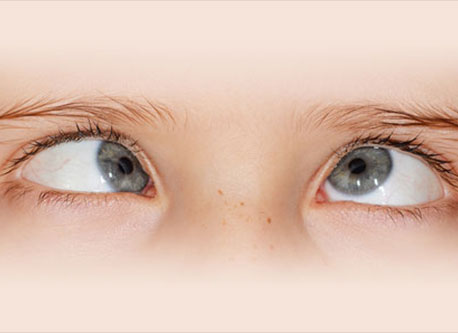Eye Squint (Strabismus)
published on: 14th march, 2023
What is Eye Squint or Strabismus?
Eye Squint or Strabismus is also referred to ocular misalignment or misalignment of the eyes which may occur at any age. Misalignment refers to the eye which are not lined up to look at the same thing wherein one eye is fixed to on what the person intends to look at the (fixing eye) and the other eye is looking at something else (the deviated eye). While it has been regarded as failures of development from birth, it has been noted to begin when an individual reaches two and a half to three and a half year period; with its peak of incidence during the second to fifth years.
What are the effects of Eye Squint or Strabismus to one's vision?
- Very rarely seeing of 2 different objects in the same place or images appear to merge into one another, a condition termed as Visual Confusion.
- More commonly, for cases of acute squint, two images double/image is seen. One image is from the fixing eye which appears normal and the image from the deviated eye usually appears blurred.
- For longer standing squint, the second or blurred image as seen by the deviated eye is ignored or suppressed by the brain.
- Reduced depth perception.
- Amblyopia or lazy eye.
What are the forms of Eye Squint or Strabismus?
- Cross-eyed (Esotropia)
- Wall-eyed (Exotropia)
- Upward deviation (Hypertropia)
- Downward deviation (Hypotropia)
What are the causes of Eye Squint or Strabismus?
- Congenital tendency for the eyes to deviate.
- Defective nerves or muscles because of different reasons.
- Farsightedness (Hypermetropia) and need for spectacles.
- Serious disease affecting the nervous system or eye.
What are the benefits of treatment-optical/surgocal to starighten the eye vision?
- Development or restoration of binocular vision or binocular depth perception.
- Elimination of double vision.
- Restoration of normal head posture
- Increased visual field.
- Creation of normal appearance
References:
- JethaniJN, Shah N, Amin S, Jethani M. Stability, and effects of muscle transplantation for very large angle esotropia; a study of 22 patients. Indian J Ophthalmol. 2017;65(7);607-609. doi: 10.4103/ijo.lJO_54_17.
- Pineles SL, Chang MY, Holmes JM, Keknnaya R, Ozkan SB, Velez FG. Innovative techniques for the treatment of adult strabismus. J Aopos. 2019; 23:132-139 doi:10.1016/j.jaapos.2018.10.018.
- Kar S, Chodhary T, Geh V, Skhija J. Muscle transplantation for large angle horizontal strabismus. J Pediatr Ophthalmol Strabisms. 2020;57: e59-e62. Doi:10.3928/01913913- 20200527-03.
- Kannam, M., Straye, J., Kapoor R. Tibrewal, S., Keknnaya, R., & Sachdeva, V. (2021). Horizontal rectus muscle transplantation for recurrent and residual strabismus. Strabismus 1-9.
- Sekerogl HT, Tran KE, zn S, Sener EC, Sana AS. Horizontal muscle transposition or oblique muscle weakening for the correction of V pattern? Eye, 2014; 28: 553-556
- Abrahamsson, M., Magnsson, G., & Sjostrand, J. (1999). Inheritance of strabisms and the gain of sing heredity to determine poplations at risk of developing strabismus. Acta Ophthalmologica Scandinavica, 77(6), 653-657.
- Schlossman, A., & Priestley, B. S. (1952). Role of heredity in etiology and treatment of strabismus. AMA archives of ophthalmology, 47(1), 1-20.
- Costenbader, F., Bair, 0., & McPhail, A. (1948). Vision of strabismus: a preliminary report. Archives of Ophthalmology, 40(4), 438-453.
- Lipton, E. L. (1970). A study of the psychological effects if strabismus. The Psychoanalytic study of the child, 25(1), 146-174.
- Helveston, E. M. (2010). Understanding, detecting, and managing strabismus. Community eye health, 23(72}, 12.
DID YOU KNOW?
An Eye Squint or Strabismus, as it is medically named, is a condition when the eyes appear to be pointing in different directions. Squints are evident in children and adults, commonly they can affect 1 in 20 children.
recent posts
- Understanding Blepharitis: Causes, Symptoms, and Treatment Options
- The Role of Technology in Cataract Surgery: Abu Dhabi's Latest Techniques
- Understanding Keratoconus: Causes, Symptoms, and Diagnosis in Abu Dhabi
- Clearing the Fog: Understanding Glaucoma's Silent Threat to Vision
- Battling the Eye's Bumps: All You Need to Know About Pinguecula
- Understanding Pinguecula: Causes, Symptoms, and Management
- What Should I Consider When Choosing the Best Eye Hospital in Abu Dhabi?
- What is Diabetic Retinopathy?
- Diabetic Retinopathy
- What is Glaucoma?
- Keratoconus
- Cataract
- Dry Eyes Syndrome
- Chalazion
2024. All Rights Reserved Samaya Specialized Center
